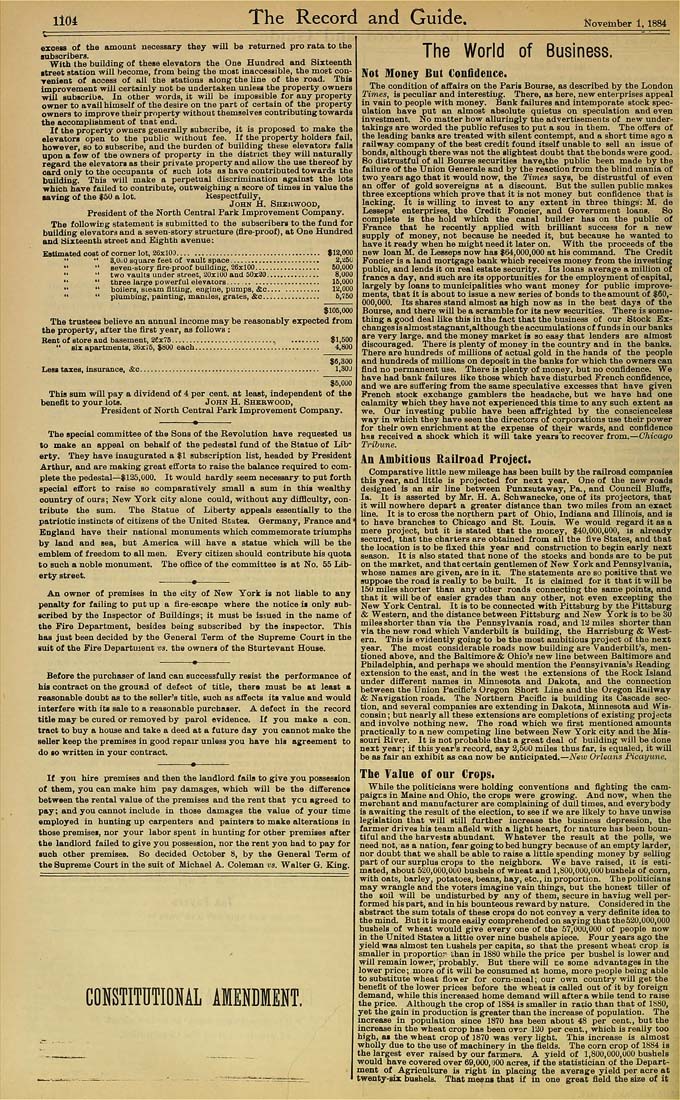
Text version:
Please note: this text may be incomplete. For more information about this OCR, view
About OCR text.
1104 The Record and Guide. Novetnber 1, 18£ exoeu of the amount necessary they will he returned pro rata to the subscriber a. With the budding of theae elevators the One Hundred and Sixteenth ■treet station will become, from being the most inaccessible, the most con¬ venient of access of all the stations along the line of the road, Tbia improvement will certainly not be undertaken unless the property owners will subscribe. In otber words, it will be impossible for any property owner to avail himaelf of the desire on the part of certain of the property owners to improve their property without themselves contributing towards the accomplishment of tnat end. If the property owners generally subscribe, it is proposed to make the elevators open to the public without fee. If the property holdera fail, however, ao to subscribe, and the burden of building theae elevators falls upon a few of the ownera of property in tha district they will naturally regard the elevatora as their private property and allow the use thereof by card only to the occupants of such iota as have contributed towards the building, Tbis will make a perpetual discrimination against the lota wbich have failed to contribute, outweighing a score of timea in value the ■aving of the |50 a lot, Respectfully, John H, ShkjiwooDj President of the Horth Central Park Improvement Company. The following statement ia aubinitted to the subscribera to the fund for building elevators and a seven-story structure (flre-proof), at One Hundred and Sixteenth street and Eighth avenue: Eatimated cost of corner lot, 26x103....................................... $18,000 " ■' 3,U
While the politicians were holding conventions and fighting the eam- paigi:a in Maine and Ohio, the crops were growing. And now, when the merchant and manufacturer are complainmg of dull times, and everybody ia awaiting the result of tbe election, to see if we are likely to have unwise legislation that will still further increase the business depression, the farmer drives bis team aSeld with a light heart, for nature has been boun¬ tiful and the harvests abundant Whatever the result at the polls, we need not, as a nation, fear going to bed hungry because of an empty larder, nor doubt that we shall be able to raise a little spending money by selling part of our surplus crops to tbe neighbors. We have raised, it is esti¬ mated, about 52O,O0O,OUO bushels of wheat and 1,800,000,000 bushels of com, with oats, barley, potatoes, beans, bay, etc., in proportion. The poHticiana . may wrangle and the voters imagine vain things, but tbe honest tiller of the soil will be undisturbed by any of them, secure in baviug well per¬ formed hispart, andinhis bounteous reward by nature. Considered in tbe abstract the sum totals of theae crops do not convey a very definite idea to the mind. But it ia more easily comprehended on saying that the5;^,000,000 buahels of wheat would give every one of the 57,000,000 of people now in the United States a httle over nine buahela apiece. Four yeara ago tbe yield was almost ten Lushels per capita, so that the present wheat crop is smaller in proportior than in 1880 wbile the price per bushel is lower and will remain lownr, probably. But there will Ce some advantages in the lower price; more of it will be consumed at home, more people being able to substitute wheat flower for corn-meal; our own country will get the benefit of tbe lower prices before the wheat ia called out of it by foreign demand, while this increased home demand will after a whfie tend to raise the price. Although the crop of 1SS4 is smaller in ratio than that of IbSO, yet the gain In production is greater than the increase of population. The increase in population since 1870 has beeu about 48 per cent., but tbe increaae in the wheat crop has been over 130 per cent,, which is really too high, aa the wheat crop of 1870 was very fight, Thia increase ia almost wholly due to the use of macbinerv in the fields. The corn crop of 1884 is the largest ever raised by our faiiners. A yield of 1,800,000,000 bushels would have covered over 69,000, JOO acres, if the statistician of tbe Depart¬ ment of Agriculture ia right iu placing the average yield per acre at twenty-six bushels. That means that if in one great field the size uf it
